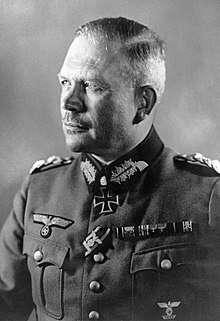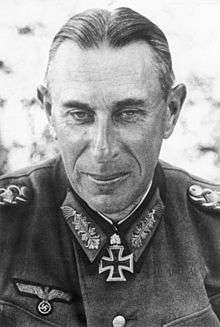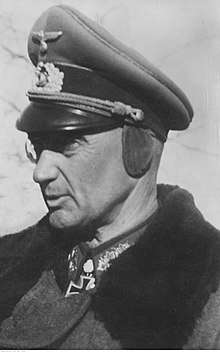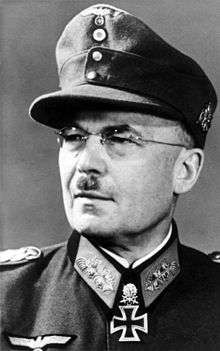2nd Panzer Army
The 2nd Panzer Army (German: 2. Panzerarmee) was a German armoured formation during World War II, formed from the 2nd Panzer Group on October 5, 1941.
| 2nd Panzer Army | |
|---|---|
| 2. Panzerarmee | |
 Insignia | |
| Active | 5 June 1940 – 8 May 1945 |
| Country | |
| Branch | Army (Wehrmacht ) |
| Type | Panzer |
| Role | Armoured warfare |
| Size | Army |
| Engagements | |
| Commanders | |
| Notable commanders | Heinz Guderian |
Organisation
Panzer Group Guderian (German: Panzergruppe Guderian) was formed on 5 June 1940 and named after its commander, general Heinz Guderian. In early June 1940, after reaching the English Channel following the breakthrough in the Ardennes, the Panzergruppe Guderian was formed from the XIX Army Corps, and thrust deep into France, cutting off the Maginot Line. In November 1940, it was upgraded into Panzergruppe 2.
The 2nd Panzer Group (German: Panzergruppe 2) was formed in November 1940 from Panzer Group Guderian. In October 1941 it was renamed the 2nd Panzer Army. Panzer Group 2 played a significant role in the early stages of the German invasion of the Soviet Union during Operation Barbarossa in 1941 when it was a constituent part of Army Group Centre.
Operational history
2nd Panzer Group was part of the Army Group Centre during Operation Barbarossa, the invasion of the Soviet Union. Guderian's 2nd Panzer Army formed the Army Group's southern pincer while Hoth's 3rd Panzer Army formed the northern pincer destroying several Soviet armies during the opening phase of Operation Barbarossa. During the battles of Bialystok and Minsk substantial numbers of prisoners were captured and several weapons captured.
Suffering heavy losses in men and equipment, the German forces advanced deeper into the Soviet Union. The rasputitsa season (literally "roadlessness", due to heavy rains and sluggish muddy roads) began to slow down the formation's progress to a few kilometres a day. The rasputitsa was not an unusual phenomenon, but the Wehrmacht did not prepare for this contingency as the German high command had expected the German army to be in Moscow and beyond at this time, with the campaign over before the end of summer. After Minsk, the 2nd and 3rd Panzer Armies captured Smolensk in another successful pincer operation taking around 300,000 prisoners.
Hitler ordered Army Group Center to detach the 2nd Panzer Group, which was to turn southward towards Kiev to form the northern pincer at Kiev. Guderian's 2nd Panzer Army and Kleist's 1st Panzer Army locked in a pincer around Kiev to trap 665,000 Soviet prisoners. After concluding the Kiev encirclement, the German planned for the three Panzer armies to attack Moscow from different directions. 4th Panzer Army in the North around Leningrad would attack southward. Hoth's 3rd Panzer Army would attack eastward towards Moscow, while 2nd Panzer Army would turn northwest and attack Moscow from the south.
The Group's divisions had suffered heavy attrition since the beginning of invasion, and experienced shortages in fuel and ammunition due to the breakdown in logistics. By November, the situation of Guderian's Panzer Group was dire. Nonetheless, expecting the Red Army's resistance to finally collapse and driven by National Socialist military thinking, including the idea that the "will" was key to success, Guderian continued to direct his forces to attack. By early December, the final advance on Moscow failed in the face of stiffening Soviet resistance and due to shortages in men and materiel.
In August 1943, the 2nd Panzer Army was transferred to occupied Yugoslavia, where it was incorporated into Army Group F and engaged in anti-partisan operations against the Chetniks under Draža Mihailović and the communist Yugoslav Partisans under Josip Broz Tito. Despite engaging in several operations aimed to crush the partisan movement, particularly the communists, no clear victory was gained. Indeed, the partisan movement grew in size and equipment, particularly after the fall of Italian Fascism in the 1943 coup of 25 Luglio led to the mass defection and surrender of Italian units stationed in occupied Bosnia and Montenegro.
Throughout 1943-44, the 2nd Panzer Army was progressively stripped of its heavy armor destined for the war on the Eastern Front, and became a primarily motorized infantry force. It did gain specialized Alpine support from units like the Brandenburgers and 7th SS Volunteer Mountain Division Prinz Eugen divisions. However, endemic guerilla warfare cost the 2nd Panzer Army heavily, and only months after the Raid on Drvar (Operation Rösselsprung) failed to assassinate the communist partisan leadership via airborne assault, the 2nd Panzer Army and all of Army Group F were pushed out of Belgrade in a joint operation by the Partisans and Red Army during the Belgrade Offensive. The 2nd Panzer Army finished the war in disarray in modern Austria.
War crimes
As all German armies on the Eastern Front, Panzer Group 2 implemented the criminal Commissar Order during Operation Barbarossa.[1] In September 1942, the 2nd Panzer Army took part in war crimes while conducting anti-guerrilla operations in the Soviet Union. These operations killed at least a thousand people, razed entire villages, and deported over 18,500. During these operations, Jews and suspected partisans were murdered by being forced to drag ploughs through minefields.[2]
In August 1943, the army's headquarters was subordinated to Army Group F and transferred to the Balkans for anti-partisan operations. The army became primarily an infantry formation at this point and found itself committed to anti-partisan operations, and personnel were accused postwar of multiple atrocities against civilians and partisans.
After the Belgrade Offensive overtook army headquarters, surviving units of the 2nd Panzer Army were subsequently transferred to Hungary as part of Army Group South in January 1945, holding off Soviet invasion of Austria. 2nd Panzer Army took part in the Battle of the Transdanubian Hills in March 1945 before surrendering at the end of the war to both Soviet and Anglo-American forces.
Commanders
| No. | Commander | Took office | Left office | Time in office | |
|---|---|---|---|---|---|
| 1 | Generaloberst Heinz Guderian (1888–1954) | 5 October 1941 | 25 December 1941 | 81 days | |
| 2 | Generaloberst Rudolf Schmidt (1886–1957) | 25 December 1941 | 10 April 1943 | 1 year, 106 days | |
| 3 | General der Infanterie Heinrich Clößner (1888–1976) | 11 April 1943 | 3 August 1943 | 114 days | |
| 4 | Generalfeldmarschall Walter Model (1891–1945) | 6 August 1943 | 14 August 1943 | 8 days | |
| 5 | Generaloberst Lothar Rendulic (1887–1971) | 14 August 1943 | 24 June 1944 | 315 days | |
| 6 | General der Infanterie Franz Böhme (1885–1947) | 24 June 1944 | 17 July 1944 | 23 days | |
| 7 | General der Artillerie Maximilian de Angelis (1889–1974) | 18 July 1944 | 8 May 1945 | 294 days |
Order of battle
Organization of Panzer Group Guderian on 28 May 1940
| Group | Corps | Division |
|---|---|---|
| Panzer Group Guderian General der Panzertruppe Heinz Guderian |
XXXIX Army Corps (mot.) Generalleutnant Rudolf Schmidt |
1st Panzer Division Generalleutnant Friedrich Kirchner |
| 2nd Panzer Division Generalleutnant Rudolf Veiel | ||
| 29th Infantry Division (mot.) Generalmajor Willibald Freiherr von Langermann und Erlencamp | ||
| XXXXI Army Corps Generalleutnant Georg-Hans Reinhardt |
6th Panzer Division Generalmajor Werner Kempf | |
| 8th Panzer Division Generalleutnant Adolf-Friedrich Kuntzen | ||
| 20th Infantry Division (mot.) Generalleutnant Mauritz von Wiktorin |
June 22, 1941
| Group | Corps | Division / Regiment |
|---|---|---|
| 2nd Panzer Group Generaloberst Heinz Guderian |
XXIV Panzer Corps | 3rd Panzer Division |
| 4th Panzer Division | ||
| 10th Infantry Division | ||
| 1st Cavalry Division | ||
| XLVI Panzer Corps | 10th Panzer Division | |
| SS Infantry Division Das Reich (mot.) | ||
| Infantry Regiment Großdeutschland | ||
| XLVII Panzer Corps | 17th Panzer Division | |
| 18th Panzer Division | ||
| 29th Infantry Division (mot.) | ||
| Anti-Aircraft Regiment Hermann Göring |
July 27, 1941
| Group | Corps | Division / Regiment |
|---|---|---|
| 2nd Panzer Group[3] | VII Corps | 7th Infantry Division |
| 23rd Infantry Division | ||
| 78th Infantry Division | ||
| 197th Infantry Division | ||
| XX Corps | 15th Infantry Division | |
| 268th Infantry Division | ||
| IX Corps | 263rd Infantry Division | |
| 292nd Infantry Division | ||
| 137th Infantry Division | ||
| XLVI Panzer Corps | 10th Panzer Division | |
| SS Infantry Division Das Reich (mot.) | ||
| Infantry Regiment Großdeutschland | ||
| XXIV Panzer Corps | 3rd Panzer Division | |
| 4th Panzer Division | ||
| 10th Infantry Division (mot.) | ||
| XLVII Panzer Corps | 18th Panzer Division | |
| 17th Panzer Division | ||
| 29th Infantry Division (mot.) |
September 30, 1941

| Group | Corps | Division / Regiment |
|---|---|---|
| 2nd Panzer Group Generaloberst Heinz Guderian |
XLVIII Panzer Corps | 9th Panzer Division |
| 16th Infantry Division (mot.) | ||
| 25th Infantry Division (mot.) | ||
| XXIV Panzer Corps | 3rd Panzer Division | |
| 4th Panzer Division | ||
| 10th Infantry Division (mot.) | ||
| XLVII Panzer Corps | 17th Panzer Division | |
| 18th Panzer Division | ||
| 20th Infantry Division (mot.) | ||
| XXXIV Corps | 45th Infantry Division | |
| 134th Infantry Division | ||
| XXXV Corps | 296th Infantry Division | |
| 95th Infantry Division | ||
| 1st Cavalry Division |
November 30, 1943
| Group | Corps | Division / Regiment |
|---|---|---|
| 2nd Panzer Army Generaloberst Lothar Rendulic |
III SS Panzer Corps | 11th SS Panzergrenadier Division Nordland |
| SS Panzer Grenadier Brigade Nederland | ||
| V SS Mountain Corps | 7th SS Division Prinz Eugen | |
| 118th Jäger Division | ||
| 181st Infantry Division | ||
| 369th (Croatian) Infantry Division | ||
| 1st Mountain Division | ||
| XV Mountain Corps | 1st Cossack Division | |
| 114th Jäger Division | ||
| 264th Infantry Division | ||
| 371st Infantry Division | ||
| 373rd (Croatian) Infantry Division | ||
| XXI Mountain Corps | 100th Jäger Division | |
| 297th Infantry Division | ||
| LXIX Reserve Corps | 173rd Reserve Division | |
| 187th Reserve Division | ||
| 367th Infantry Division | ||
Notes
- Stahel 2015, p. 28.
- www.verbrechen-der-wehrmacht.de p. 22
- Glantz, David, Barbarossa Derailed: The battle for Smolensk, Volume 2, November 2010, page 54
Sources
- Stahel, David (2015). The Battle for Moscow. Cambridge, UK: Cambridge University Press. ISBN 978-1-107-08760-6.CS1 maint: ref=harv (link)





